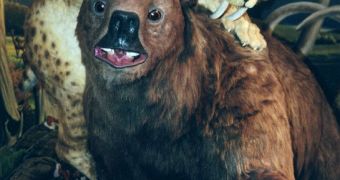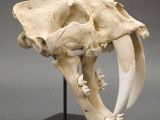These were the horror cats of our prehistory. But as it wasn't the case with T-rex, Stone Age people had to face these beasts. A new research has shown the way the terrible predators used to kill their prey and the surprise is that, despite their huge fangs, the bite of these predators was surprisingly weak.
Smilodon fatalis lived in grasslands from North America to South America (in the west coast down to Peru) being almost the size of a modern lion, but much squatter: 300 to 450 lb (130 to 200 kg); large lion males grew up to 275 kg (but in rare cases). Their canines were 7 in (18 cm) long! (a lion's canines hardly reach 3.2 in or 7 cm in length). "Ice Age" series turned Smilodon into a movie star.
Smilodon is wrongly often called a saber-toothed tiger, as it is not closely related to any living cat. About 9,000 years ago, the saber-tooth cats went extinct.
Since their discovery during the 19th century, researchers have wondered how the cat used its enormous knifelike canine to kill impressive prey, like bison, horses and perhaps even young mammoths and mastodons. The new research compared the skulls of Smilodon and modern lions, finding that Smilodon's bite had just one-third of the strength of a lion's bite.
"For all its reputation, Smilodon had a wimpy bite," said co-author Stephen Wroe, a paleontologist at the University of New South Wales.
"We simulated the forces you might expect if each one was taking large prey," said lead author Colin McHenry of the University of Newcastle
The "computerized crash tests" revealed that Smilodon could not bite a prey that was still on its feet and struggling: the sabers (canines) would have been broken and the cat's skull would not hold up to the associated forces, while the lion's skull coped easily with this.
The weaker power of the Smilodon's bite was due to the relatively smaller lower jaw, a trait designed to accommodate the cat's huge sabers. That's why the extinct cat had a different killing technique from lions and tigers. The researchers believe Smilodon employed its powerful forelimbs and huge claws to take down a prey and immobilize it to make use of the formidable sabers.
"The saber-cat had an immensely powerful body, perfect for wrestling large prey to the ground, and our models show that it needed to do this before trying a bite. Killing was more likely applied to the prey's throat, because it is easier to restrain the prey this way. Once the bite was done, the prey would have died almost instantly." said McHenry.
The ambush was followed by a rapid kill, while lions often asphyxiate a large prey through a bite that lasts many minutes. But carrying such a heavy muscle mass for taking down large prey meant Smilodon was not so agile to catch smaller, rapid animals (like deer and antelope), as lions do. Because of this Smilodons went extinct along with their prey at the end of the glaciation era.
"[Smilodon] sacrificed the ability to catch small prey, and when the large prey disappeared at the end of the last Ice Age, it went with them," said McHenry.

 14 DAY TRIAL //
14 DAY TRIAL // 
